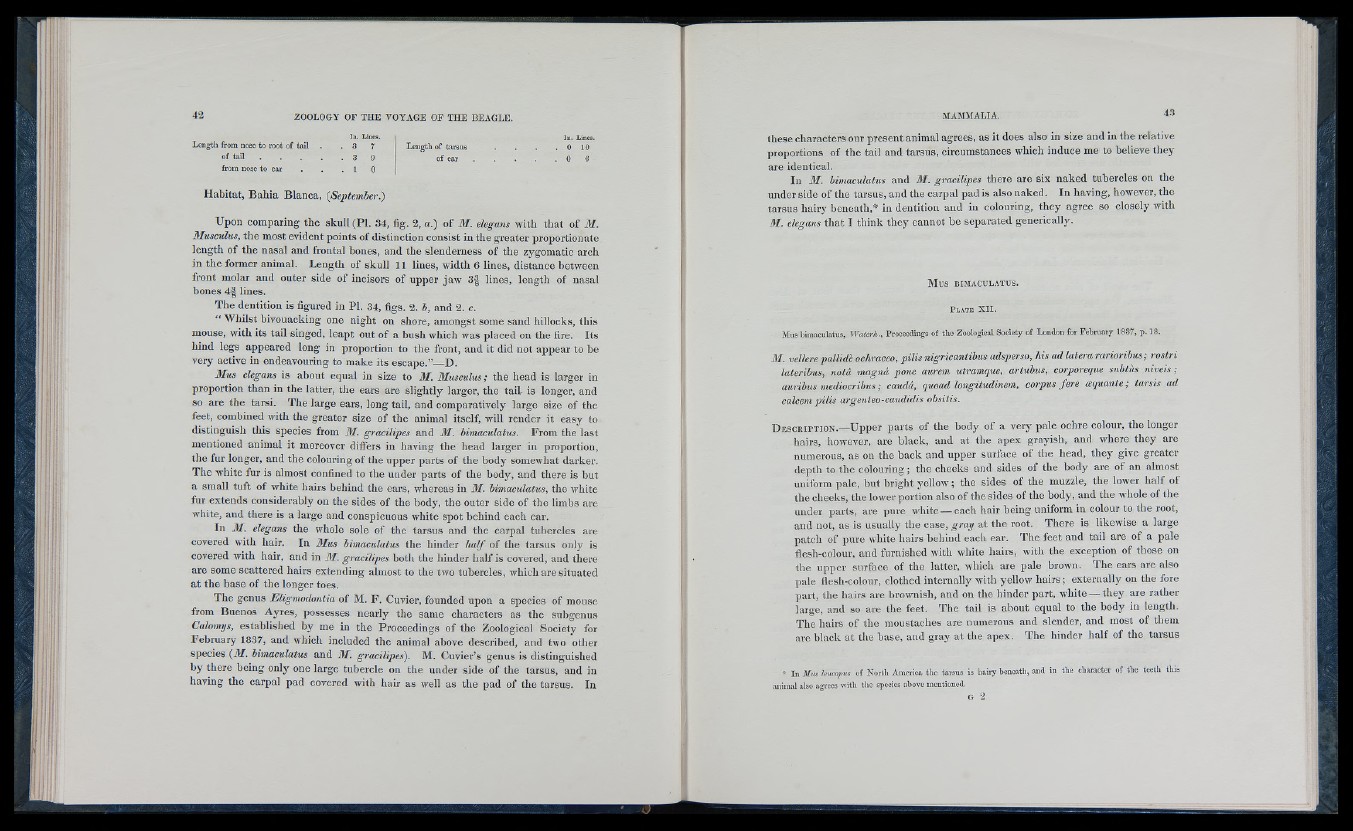
/ - ? *
J
Length from noso to root of tail
of tail
from nose to ear
Iu. Lines.
3 7
8 9
1 0
Length of tarsus
of ear
Iu, Lines.
0 10
0 6
Habitat, Bahia Blanca, (September.')
Upon comparing the skull (PI. 34, fig. 2, a.) of M. elegans with that of 31.
3Iusculus, the most evident points of distinction consist in the greater proportionate
length of the nasal and frontal bones, and the slenderness of the zygomatic arch
in the former animal. Length of skull 11 lines, width 6 lines, distance between
front molar and outer side of incisors of upper jaw 3 | lines, length of nasal
bones 4 | lines.
The dentition is figured in PI. 34, figs. 2. b, and 2. c.
“ Whilst bivouacking one night on shore, amongst some sand hillocks, this
mouse, with its tail singed, leapt out of a bush which was placed on the fire. Its
hind legs appeared long in proportion to the front, and it did not appear to be
very active in endeavouring to make its escape.”—D.
3Ius elegans is about equal in size to 31. 3Iusculus; the head is larger in
proportion than in the latter, the ears are slightly larger, the tail is longer, and
so are the tarsi. The large ears, long tail, and comparatively large size of the
feet, combined with the greater size of the animal itself, will render it easy to
distinguish this species from 31. gracilipes and 31. bimaculatus. From the last
mentioned animal it moreover differs in having the head larger in proportion,
the fur longer, and the colouring of the upper parts of the body somewhat darker.
The white fur is almost confined to the under parts of the body, and there is but
a small tuft of white hairs behind the ears, whereas in 31. bimaculatus, the white
fur extends considerably on the sides of the body, the outer side of the limbs are
white, and there is a large and conspicuous white spot behind each ear.
In 31. elegans the whole sole of the tarsus and the carpal tubercles are
covered with hair. In 3Ius bimaculatus the hinder half of the tarsus only is
covered with hair, and in 31. gracilipes both the hinder half is covered, and there
are some scattered liairs extending almost to the two tubercles, which are situated
at the base of the longer toes.
The genus Eligmodontia of M. F. Cuvier, founded upon a species of mouse
from Buenos Ayres, possesses nearly the same characters as the suhgenus
Calomys, established by me in the Proceedings of the Zoological Society for
February 1837, and which included the animal above described, and two other
species (31. bimaculatus and 31. gracilipes). M. Cuvier’s genus is distinguished
by there being only one large tubercle on the under side of the tarsus, and in
having the carpal pad covered with hair as well as the pad of the tarsus. In
these characters our present animal agrees, as it does also in size and in the relative
proportions of the tail and tarsus, circumstances which induce me to believe they
are identical.
In 31. bimaculatus and 31. gracilipes there are six naked tubercles on the
under side of the tarsus, and the carpal pad is also naked. In having, however, the
tarsus hairy beneath,* in dentition and in colouring, they agree so closely with
31. elegans that I think they cannot he separated generically.
M u s BIMACULATUS.
P laxb X II.
5ÎUS bimaculatus, ^yaterh., Proceedings of the Zoological Society of London for February 1837, p. 18.
31. vellere pallidh ochraceo, pilis wigricantibus adsperso, his ad latera rarioribus; rostri
lateribus, notà magnâ pone aurem utramque, artubus, corporeque subtiis niveis ;
auribus mediocribus ; caudâ, quoad longitudinem, corpus fere cequante ; tarsis ad
calcem pilis argenteo-candidis obsitis.
D e s c r i p t i o n . — Upper parts of the body of a very pale ochre colour, the longer
hairs, however, are black, and at the apex grayish, and where they are
numerous, as on the back and upper surface of the head, they give greater
depth to the colouring ; the cheeks and sides of the body are of an almost
uniform pale, hut bright yellow ; the sides of the muzzle, the lower half of
the cheeks, the lower portion also of the sides of the body, and the whole of the
under parts, are pure white — each hair being uniform in colour to the root,
and not, as is usually the case, gray at the root. There is likewise a large
patch of pure white hairs behind each ear. The feet and tail are of a pale
flesh-colour, and furnished with wliite hairs, with the exception of those on
the upper surface of the latter, which are pale brown. The ears are also
pale flesh-colour, clothed internally with yellow hairs ; externally on the fore
part, the hairs are brownish, and on the liinder part, white — they are rather
large, and so are the feet. The tail is about equal to the body in length.
The hairs of the moustaches are numerous and slender, and most of them
are black at the base, and gray at the apex. The hinder Iialf of the tarsus
* In Mus leucopm of N orth America the tarsus is hairy beneath, and in the character of the tcctli this
animal also agrees w ith the species above mentioned.
G 2